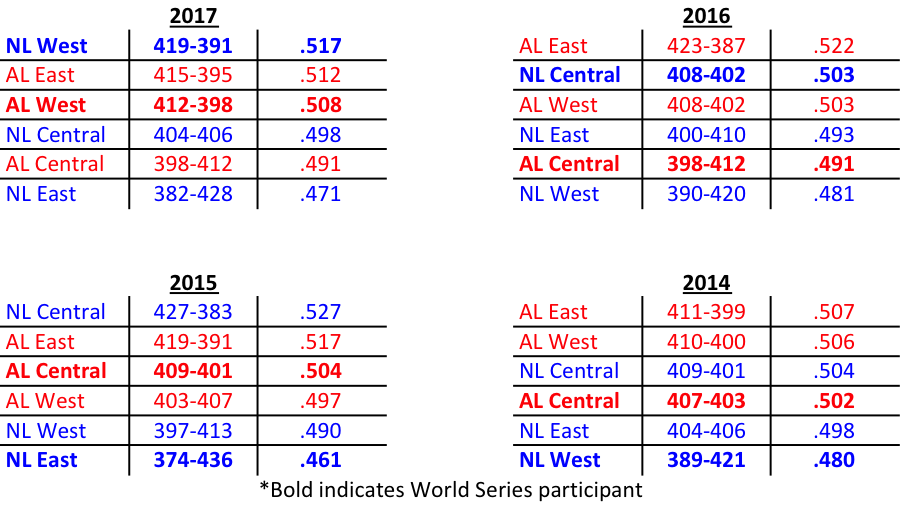 The Los Angeles Dodgers and Houston Astros are in the midst of a perennial World Series matchup. Did they make it to the pinnacle of the playoffs because they were really the better teams in their respective leagues? Perhaps they were better tested throughout the regular season with tougher division opponents whom they saw on a more regular basis.
The Los Angeles Dodgers and Houston Astros are in the midst of a perennial World Series matchup. Did they make it to the pinnacle of the playoffs because they were really the better teams in their respective leagues? Perhaps they were better tested throughout the regular season with tougher division opponents whom they saw on a more regular basis.
Playoff success is based on two simple things: making the playoffs and winning in the playoffs. The Dodgers and Astros did both as they created a fall classic featuring two 100-win teams for the first time since 1970. This shows that each team was no fluke to qualify for the post season.
Were the World Series qualifiers in weaker divisions to boost their win totals in the regular season? Or did they face tougher competition, which allowed them to be better prepared for the rigorous tests of the post season? Here’s a breakdown of total record and winning percentage by division over the last four seasons.

The Dodgers actually were in the toughest division in baseball this season with a 15 and 37 game advantage over the other National League divisions. I initially thought this was more of a knock to the Washington Nationals than an ode to the Dodgers. The NL East has been a doormat for a few seasons with multiple teams in heavy rebuilding modes. The Nationals have been dominant in the division but have yet to advance past the NLDS in any year; meanwhile, the New York Mets made it to a World Series in 2015 when they only won 90 games in the regular season.
Houston was in the second toughest American League division, with the AL West sitting only three games behind the AL East. The AL West was the third best division in baseball while the NL West was the top division in baseball. 76 of these games are negated because divisional games result in a .500 zero-sum outcome every time. Teams play 76 games against division opponents, 66 games against non-divisional opponents in the same league, and 20 interleague games. That results in 86 games, more than half of the schedule, being played against teams outside one’s division.
As you can see from preceding years, divisional ranking does not always equate to post season success. In 2016, the Joe Maddon and the Chicago Cubs were in the best NL division, while Terry Francona and the Cleveland Indians were in the worst AL division. In 2015, the Cinderella Kansas City Royals were in the second best AL division, while the New York Mets were in the worst division in baseball over the last four seasons. The 2014 World Series saw teams from the worst division in each league in the Royals and San Francisco Giants.
 With just four years of data, it is clear that it doesn’t matter which division a team is in with regards to their chance of success in the post season. The biggest benefit of being in a weaker division is the ability to clinch a divisional series berth without having to go through the wild card play-in game. The wild card game is a 1-game playoff that puts the winning team without its ace and possible bullpen pieces entering the divisional series matchup.
With just four years of data, it is clear that it doesn’t matter which division a team is in with regards to their chance of success in the post season. The biggest benefit of being in a weaker division is the ability to clinch a divisional series berth without having to go through the wild card play-in game. The wild card game is a 1-game playoff that puts the winning team without its ace and possible bullpen pieces entering the divisional series matchup.
Because of the variance in opponents over the course of the season, a team that wins its division is as deserving as a team winning a tougher or lesser division. There might be teams in a given division with winning percentages ranging from .400 (65 wins) to .600 (97 wins) or greater or worse. There may be a division with a cluster of .500 teams. No matter the results, there is always a handful that separates themselves from the rest.
Contenders or pretenders may be hard to figure out after 162 games. Even the worst team in baseball can beat the best team on a given day, or even a given 3-game series. Once all the flukes and surprises are played out, the better teams end up closer to a .600 percentage and the lesser teams end up closer to .400. The rest settle for hovering around .500 and figuring out whether they played above or below their actual potential.
The disparity of divisions changes from year to year, but being in a tougher division does not guarantee playoff success. Even overall record can’t guarantee anything besides home field advantage. The regular season means nothing once the playoffs begin, and then it turns into a 1 game wild card playoff, a 5 game division series, a 7 game league series, and a 7 game World Series finale. It might take 162 games to make it to the post season, but it can take only one to send a team home. It just depends on who’s hot and who’s not and who wants it more.

Leave a Reply